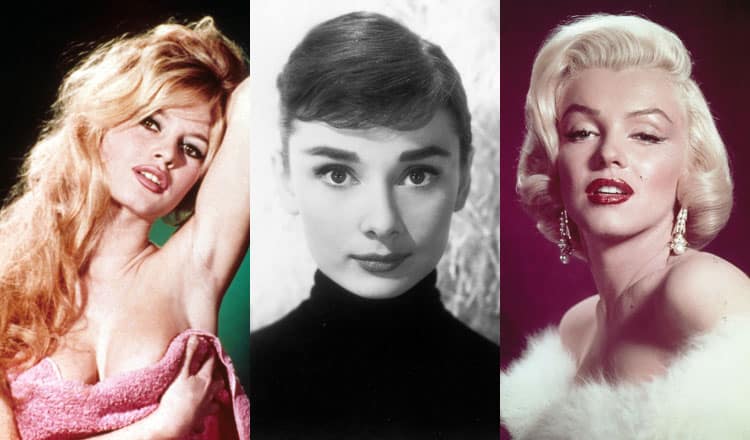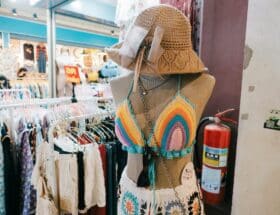By Pauline Weston Thomas for Fashion-Era.com
The British Fashion Scene Mid-20th Century
The 1950s moved Britain from the austerity of the 1940s to the prosperity of the 1960s. Fashion history would never be the same again after the 1950s when teenagers became an emerging fashion voice. A new consumer-driven society was born.
The fashionable age of being between thirty and forty at the start of 1950 was soon knocked off its pedestal before the end of the decade, by the arrival of the teenage cult with its own development of style and spending. Until then, 18-year-old girls often dressed and made themselves up to look as old as their mothers.
The fifties saw the breaking of a mould that has stayed broken as those same baby boomer adults today strive to look as youthful as possible. The clear dividing line of the decade was 1956 when the fifties began to move away from the rigid controls of the 1940s into the more flexible hedonistic 1960s when youth movements influenced fashion and lifestyles.
1950s glamour had arrived.
The British 1950s fashion scene used opportunities presented by the Second World War to capture some of the American market. The Incorporated Society Of London Fashion Designers had designed prestige garments throughout the war.
The raw materials of Scottish tweeds and English worsted suit materials were renowned as being of exceptional quality. The wools were also used by the French and the British did everything they could to promote the fine materials with fine designs. The result would be 1950s glamour.
Fashion for women returned with a vengeance and the 1950s era is known mainly for two silhouettes, that of the full skirt and the pencil slim tubular skirt, with both placing great emphasis on the narrowness of the waist.
The Festival of Britain Exhibition of 1951
The Festival Of Britain Exhibition of 1951 held at the South Bank on the River Thames in London produced over 6000 products many of them clothing, accessories, and dress fabrics. The items were seen by the visitors as luxury items because they were in colors, designs, and fabrics mostly never seen before.
The British government had the materials, but to help rebuild the economy they quietly traded the goods abroad and did everything they could to promote the fine materials. They achieved this by depriving the British people of access to the materials for as long as they possibly could.
For the many visitors it was both an uplifting and depressing experience all at once, as almost all the goods were destined 'For Export Only'. The festival highlighted a Britain on the edge of becoming a huge consumer society, soon to follow trends and glamour first set in America.
Marks and Spencer Fashion in the 1950s
In the late fifties, early sixties, a popular style was the knitted sweater dress with crew, shirt tab front or cowl necks and made from Orlon or Lambswool. It was a warm garment in a Britain still not centrally heated and it was made universally popular by Marks & Spencer. Beneath the sweater dresses women wore long line bras and girdles that covered the individual thighs.
The higher standard of manufacture of utility clothes had ironed out pre-war problems and new skills had been gained that enabled designers, manufacturers and chain stores to produce quality goods to a high specification. After the war mass produced ready made clothes were far removed from the shoddy workmanship of pre-war days and any stigma attached to early ready made clothes was forgotten once royalty bought ready made clothes.
Marks & Spencer literally became part of the nation's fabric in the following fifty years so that today ordering worldwide from them via the internet is a simple operation for fast delivery, but at present to addresses in the UK only.
Norman Hartnell Designs Queen Elizabeth II's Robes
The work of Norman Hartnell with limited resources in producing a wedding dress for Princess Elizabeth in 1947 was outstanding. Go to the page about the Queen's Wedding Dress. When the Princess was crowned Queen Elizabeth II in 1953, Norman Hartnell once again designed her lavish shimmering gown. I have seen this gown on display and the colored beadwork is very pastel and extremely subtle, but dense. Go to the page about the Queen's Coronation Gown.
Millions in the UK and elsewhere in the world saw the coronation on a friend or neighbor's small screen black and white television. For millions it was the first time they ever saw television and shortly after sales of television sets in the UK boomed, bringing ideas and fashions to the masses. This was costume history in the making.
Dior's New Look 1947
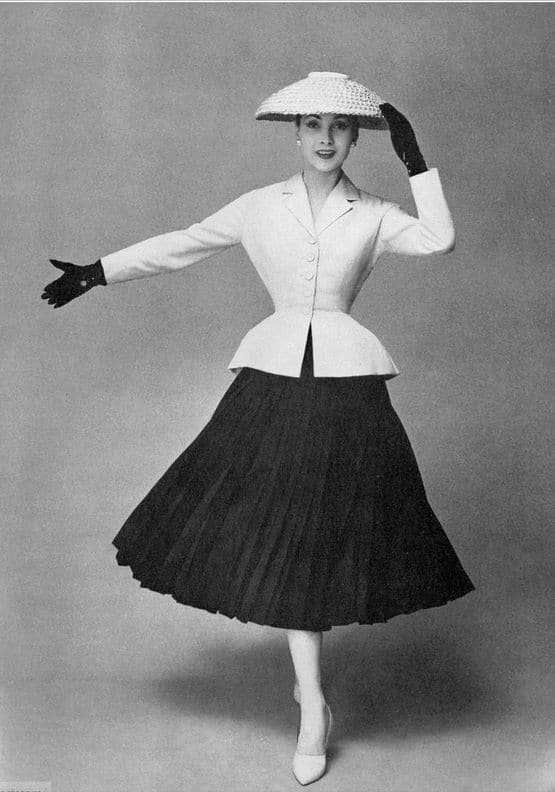
A Post-War Turning Point in Fashion History
In 1947 Christian Dior presented a fashion look with a fitted jacket with a nipped in waist and full calf length skirt. It was a dramatic change from wartime austerity styles.
After the rationing of fabric during the Second World War, Dior's lavish use of material was a bold and shocking stroke.
His style used yards and yards of fabric.
Approximately 10 yards were used for early styles. Later Dior used up to 80 yards for newer refinements that eliminated bulk at the waist.
The New Look and new approach to fashion was a major post-war turning point in Fashion History.
Dior's timing made his name in fashion history. After the war women longed for frivolity in dress and desired feminine clothes that did not look like a civilian version of a military uniform. Life magazine dubbed Dior's Corolle line the New Look in 1947. Evening versions of the New Look were very glamorous and consisted of strapless boned tops with full skirts and were ultra feminine.
The shaped fitted jacket Dior designed with his New Look full skirt was also teamed with a straight mid calf length skirt. Women usually wore just underwear beneath the buttoned-up jacket or filled in the neckline with a satin foulard head scarf, dickey, or bib.
Dior's New Look dominated the fashion world for about ten years but was not the only silhouette of the era. 1956 was the year that introduced visible changes that separate the early fifties from the late fifties. It places that fashion era firmly alongside the stuffy formality of the forties, whilst putting the post-1956 period firmly into the start of the livelier, anything goes sixties fashion period, often dominated by the young of the day.
There were those in the 1950s that rebelled against the pristine immaculate groomed look, so often associated with Grace Kelly's elegance. Leslie Caron and Audrey Hepburn both often wore simple black sweaters, flat shoes and gold hoop earrings coupled with gamine-cropped short haircuts. They gave a continental alternative often described as chic and had many fashion followers seeking to embrace the modern.
Paper Nylon and Net Petticoat Support 1950s
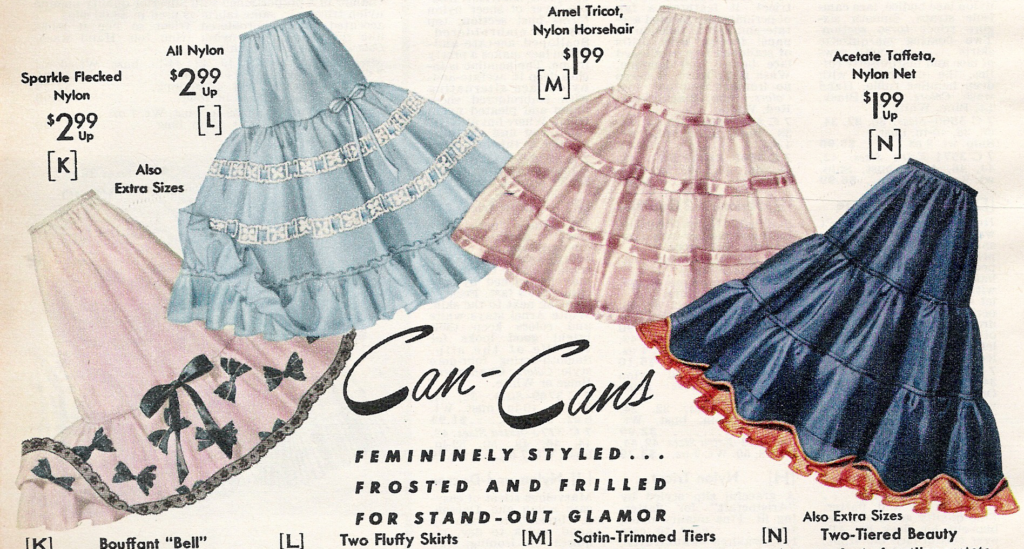
The full skirts needed support to look good and nylon was used extensively to create bouffant net petticoats or paper nylon petticoats. Several petticoats often of varying styles were worn to get the 'just right' look of fullness which progressed from a gentle swish to a round ball-like bouffant effect by the sixties.
Each petticoat was stiffened in some way either by conventional starch or a strong sugar solution. Eventually, a hoop crinoline petticoat was developed and it had channelled tapes which were threaded with nylon boning in imitation of whalebone petticoats. A single net petticoat worn over it softened the look of the rigid boning.
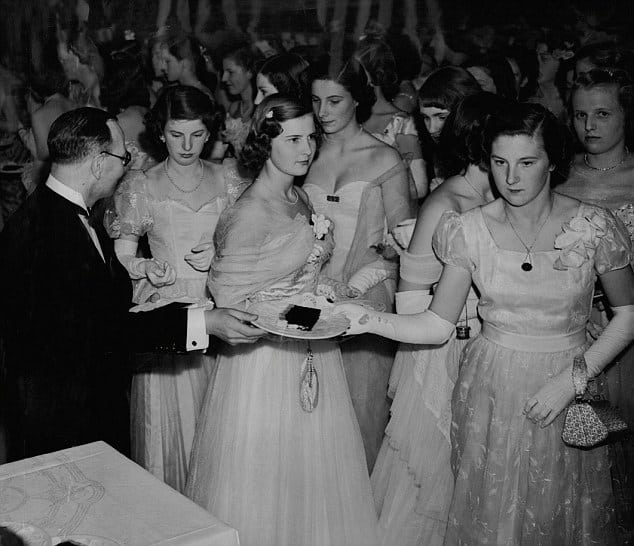
The full skirts needed support to look good and nylon was used extensively to create bouffant net petticoats or paper nylon petticoats.
Several petticoats often of varying styles were worn to create fullness and some are shown on the 50s girdles and stockings pages.
Mars & Spencer still sell great petticoats today.
to the right: late 1950s - 3 women at a ball wearing lace and tulle-boned bodice dresses with full skirts.
All of these women were over 40 when this picture was taken and looked just as good in their fashion era as women over 40 do today.
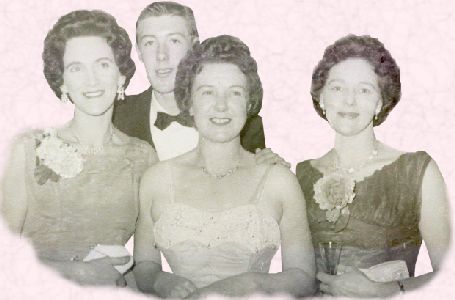
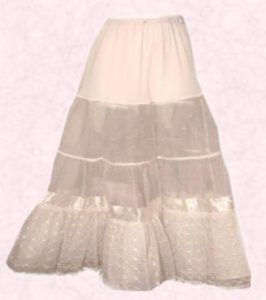
Their hairstyles follow the fashion of Queen Elizabeth II and Elizabeth Taylor.
The full skirts of these dresses were supported by tiered nylon tulle petticoats such as the drawing left or like the real one shown below.
You may wish to view more crinoline styles for costuming purposes in the section Victorian Crinolines.
Coat by Jacques Fath
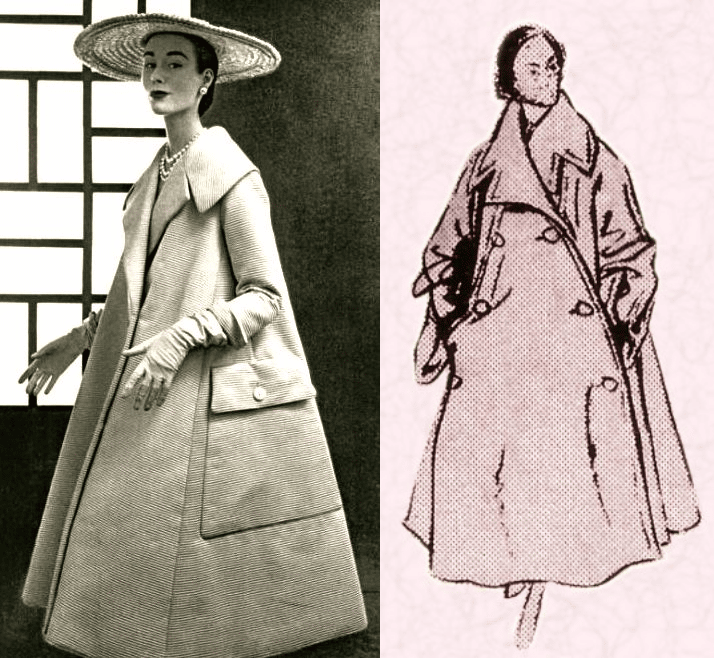
Another influential fashion silhouette of the period was that of the late 1940s swing coat by Jacques Fath, which was a great shape to cover up full skirts and an ideal silhouette for the post-war high pregnancy rate.
This style was also often made as a loose full tent line duster coat, but often without the double-breasted feature and buttons shown here.
Fifties Silhouettes Fashion History
In contrast to the full-skirted New Look, Chanel who had reopened her fashion house in 1954 began to produce boxy classic Chanel suit jackets and slim skirts in braid-trimmed, nubbly, highly textured tweeds.
She used richly textured wool slub fabrics sometimes designed by the textile artist Bernat Klein. The silhouette was straight down and veered away from a nipped-in waist. The beautifully made suits were lined with lovely silk fabrics.
They were weighted along the facing join and inside lining with gilt Chanel chains.
The fashion look was easy to copy and very wearable. Major chain stores sold suits based on the design. Accessorized with strings of pearls the style has frequently been revived over the seasons and in particular, a collarless style of coat and jacket she popularised, is now called the Chanel line.
The collarless Chanel line jacket was hugely popular again in both the 1980s and the 1990s.
America in particular bought Chanel's designs in large numbers. Her influence of boxy suits of the fifties has far more bearing on sixties fashion style, than Dior's New Look design.
H, A, Y Lines, Sack, Trapeze, And Empire Dresses
1955 - The A-line Style from Dior
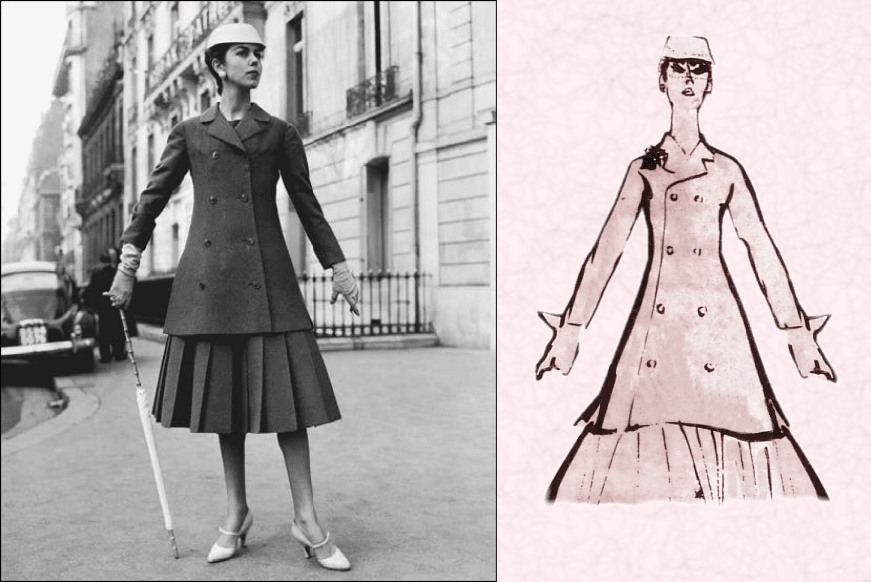
During the 1950s Dior showed his H, A, and Y lines.
The H-line of 1954 was a slender tunic suit with a slim skirt that later became more of a dropped waist tubular twenties style dress with a hemline that was creeping upwards.
This would become a classic 1950s fashion garment.
The Sack
Hubert Givenchy designed a Paris collection dress in 1957 called the sack and it started the trend for straighter waistless shift dresses.
First, it developed into the fitted darted sheath dress and later into the loose straight short shift dress. By 1958 the style really began to catch on.
The design was picked up by Mary Quant who modified it to her taste. Various refinements on this early sack dress picked up by Courrèges, led Quant to go one step further and design the mini shift dress that was to dominate the 1960's decade.
The Trapeze to Tent
The trapeze dress was a swinging dress almost triangular in shape and designed to be worn with low shoes and bouffant hairstyles.
Over the years it too was modified into the short baby doll tent style making the 60's version. A shaped Tent dresses with cutaway armholes were an alternative look of the sixties.
The 1950s/1960s Empire Line
The Swoop Line 1955
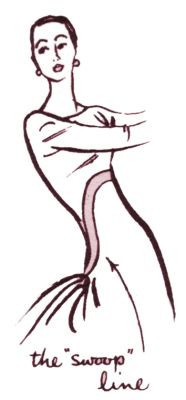
Similarly, the empire line dress that had been introduced in 1958 was loved by young teenagers who looked childlike in the style, hence phrases like "baby doll style" were applied to it.
The Empire Line dress of 1958 was loved by young teenagers who looked childlike in the style and the opposite of looking 'grownup' like their mothers which by then was the worst possible 'fashion' look to have.
Chanel's Attitude and Her 50's Silhouettes
Chanel was already criticizing the boned bodices promoted by Dior as backward-looking. The emerging new society was only too willing to agree with her. However as mentioned above, Dior's looser freer styles were partially the starting point for Quant's early designs.
Chanel was astute enough, to know that couture had a limited future. Its influence was morphing into one that would culminate in branding and ready-to-wear designer labels in the next decades. Couture Design House's survival now depended not on the depleted 3000 private rich customers, but on selling designs to the mass market.
A Chanel Suit Design
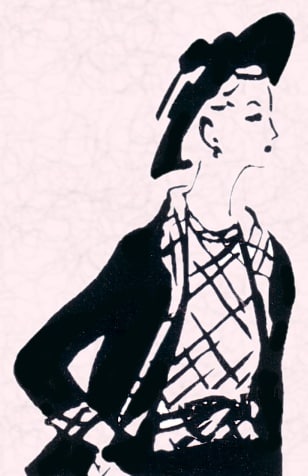
In Britain, Haute Couture models began to be licensed to companies like Wallis and soon provided a useful source of income. Macy's of New York paid huge sums of money for an individual Toile, a linen or calico copy of the designer model garment.
Every piece of information they needed to make the garment as a near copy would be provided. Details of trimmings, buttons, fasteners, etc. were all part of the price paid.
With thousands of copies constructed, Macy's could afford to sell a dress worth $1000 for $100. If they sold a superior more exact version as a limited copy, they could sell it as a designer original and reap the reward of a higher designer price.
New Synthetic 1950s Fashion Fabrics
Fashion history shows that styles and garments of the fifties and sixties were revolutionized by new fabrics. Many of the 1950's fabrics were synthesized from petrochemicals. They were promoted for their easy care wash and wear qualities which often meant a quick rinse and drip dry with minimal or no ironing required. Initially, they were novel, but expensive materials. Crimplene at first could only be bought in high-class Madame shops.
Nylon (Polyamide), Crimplene (Polyester), and Orlon (Acrylic/ Polyacrylonitrile) were all easy to look after and were soon affordable. Crimplene enabled everyone to wear white and pastel colors because they could be washed easily as polyester does not yellow like white nylon does with age and sunlight.
The fabric is also tailored well and could be made into button front, double breasted, wide collar dresses and retain a crisp appearance through washing.
In the early fifties, America had easier access than the UK to really attractive man-made fiber goods. Many UK people had their first nylon goods from America in parcels sent by American pen pals. I recall receiving beautiful silky lemon nylon pajamas one Christmas and being so excited about them.
But best of all, I received the following year a beautiful lemon nylon, tiered party dress even better than the PJs. I will never forget how wonderful that frilled and very pretty dress seemed - Sheila Sapp of Oakland Avenue, Ohio if ever you read this I thank you.
The Alternative Slim Silhouette of the 1950s
Such dresses were usually made of hardwearing wool Barathea suiting material and often had a large white organdie collar and cuffs with a bias bound edge that could be detached and washed, then sewn back into position.
Such cuffs were called French cuffs. The handbag is a style similar to the famous Kelly bag.
The new fabrics of nylon and polyester were ideal for women's trousers and ski pants styles.
Mock suede or suedeen jackets were made from the new fibers and were worn with tapered nylon stretch knit trousers often made by Slimma or Marks & Spencer

1950-60 Hairstyles
Throughout the early 1950s, the ponytail was a popular youthful hairstyle and it matured into the French pleat. Fashionable hairstyles began with simple ponytails and ended the decade with complex beehive arrangements.
Popular hairstyles in the 1950s and 60s were the poodle cut the French pleat and later the beehive which began at the tail end of the 50s.
For the more sophisticated, a permanent wave in the styles favored by Elizabeth Taylor and the young Queen Elizabeth II were universally worn. Their popular bubble-cut hairstyles were easily copied with the advent of improved hair products, particularly home perms.
Other stars that captured the look of the day were Leslie Caron, Audrey Hepburn, Sophia Loren, Brigitte Bardot, and Doris Day.
Hairdressing was so big, that by 1955 almost 30,000 salons had sprung up in Britain. As products such as hair lacquer sprays and plastic rollers came into general use it was easily possible for ordinary women to create more and more complex hairstyles of height.
By the late 50s, outrageous backcombed bouffants, beehives, and French pleats led the way for the intricate coiled hairstyles of the 1960s. Women mostly bought their hair lacquer from their hairdresser and decanted it at home into nylon puffer spray bottles.
By the end of the 50s, hair spray in cans, commercial shampoo, conditioner, and rollers all became big businesses that boomed in the sixties.
Dusty Springfield and her Beehive Hairstyle.
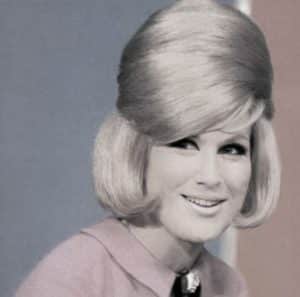
Dusty Springfield's beehive and eye makeup was copied throughout Britain. Lavish backcombing was hair sprayed and the style teased, prodded and smoothed into a high mound.
After Dusty Springfield's beehive came the Beatle cut and Vidal Sassoon's five-point cut bobbed style.
Mary Quant sported a Sassoon haircut A softer fringed haircut followed the Beatle's rise to fame and a cover album where all four Beatles wore black polo neck sweaters.
Image right of Dusty Springfield the British singer and her beehive hairstyle. This half-up, half-down style was a compromise between wearing the hair up and wearing it down.
Teens in the 50s
1950's Teenage Consumers
Until 1950 the term teenagers was not in general use. Children were known as girls and boys were called youths once they displayed signs of puberty.
Then young people were grown up at 18 and fully adult legally at 21 when they often married and set up a home of their own even if it was a rented room. Getting married was a way of showing the adult world that you belonged to their world and was a way of escaping from puberty.
During the 1950s a range of influences including film, television, magazines, and the rock music scene created a new market grouping called teenagers. A sudden flurry of consumer goods denied to war-torn Europe were available and a consumer boom was actively encouraged. Teen clothes, that were specifically intended to be bought by teenagers became available.
You can read more about 1950s teenage consumers and teddy boys.
Whit Sunday in the 1950s
Most of the British nation still kept religious holidays like Whitsunday and Whit Monday when the mixed congregations from chapels and churches would march through British towns parading their chapel banners and wearing their Sunday best.
The clothes would follow the up-to-date fashions of the time and be sparkling clean often in the new fabrics. Girls dresses were almost always in nylon with skirts puffed out with petticoats.
Children and families would be gathered together for a few family photographs to be taken with cousins and neighbors. The photographs were often only taken at Whitsunday and show how formal the dress of girls was even then.
They always wore gloves for the occasion and sometimes fake flower corsages were usually made from stiffened fabric such as organdie or cotton.
Young women attempted to be as glamorous and grown-up-looking as their mothers or especially as royalty or film stars of the day. Film stars such as Elizabeth Taylor, Doris Day, Debbie Reynolds, and Marilyn Monroe were popular icons of their day.
Whitsunday Best Clothes in the UK in the Mid-1950s
I am wearing a paper nylon striped raspberry pink and white modern nylon dress next to my teenage sister who is only 15 years old but is dressed to look older.
She wears a green and white, striped pique cotton, starched dress with whitened shoes and gloves to give a lady-like look.
But look at her narrow waist and you realize she is very young despite the glamour makeup.

1950s Accessories
The pointed pre-formed conically stitched bra was actually a fashion accessory as without one the sweater girl look was certainly not right. Fashionable accessories included popper beads and spectacles with enormous wings that arched in twirls upward and could be studded with rhinestones.
1950 Stockings
Seamless stockings were introduced in Britain in 1952, but the masses did not take to them as the early shaping was so poor compared to regular fully fashioned, shaped, seamed stockings. Only later in the fifties did they gain approval.
Stocking sizes ranged from size 8 to size 11 going up in half sizes. The fit varied from brand to brand, but fully fashioned seamed stockings were well shaped on the foot and heel although the yarn used was not stretchy, and sometimes a little bagging could happen so that fine wrinkles appeared.
It was essential to either check your seams were straight using a back mirror or get a sister or friend to tell you nothing was crooked. Stockings are discussed more in collecting 1950s vintage clothing.
Early 1950s Shoes
Early 1950s shoes were often very high but with rounded or peep toes and low-cut front uppers. Strapped sandals with finer heels were popular as were heavier thicker heels for lower shoes, but by the mid-fifties kitten heels and metal-tipped steel stiletto heels replaced styles that owed more to designs that had been brought out to compliment the New look of 1947.
Read more about fashion in the 1950s in my other pages such as 1950s accessories and stiletto shoes on the 1950s Accessories. I also look at sewing dressmaking patterns from the 1950s. Social history is covered and compared to today in the Way Society Lived in the 1950s, plus the 1950 to 1960 Brief Timeline Chart.
1950s Fashion - Conclusion
The Second World War left women craving for glamour, style, and swathes of fabric where scraps of material had once existed.
Dior's full-skirted and waisted designs fulfilled all the early dreams of the feminine woman in the early 50s. As a new, more liberated society evolved, women moved toward freer more relaxed clothes and began the move away from the dress rules and associated formality of decades.
